Blog: Trademarks for Amazon Sellers: Everything You Need to Know
Trademarks for Amazon Sellers: Everything You Need to Know
Selling on Amazon is a real business opportunity. Provided you go into it armed with research and prepared to put in the upfront hours to get started, you will reap the long-term benefits of running a legitimate and profitable business.
Some of the benefits of an Amazon FBA business, in particular, are that once you are up and running, it’s a relatively passive income. You rely on Amazon’s fulfillment service to manage your inventory, and once your products are launched and making money, the ongoing tasks can be pretty low maintenance compared to other business models. You can also hire a VA (virtual assistant) who is well versed with Amazon tasks that you don’t have the time to do yourself.
But as the realm of third-party selling on Amazon grows, so do some of the ‘rules and regulations’ that are required from you. But it’s not all bad news. These are just considerations that all real businesses have to make.
In this article we’re going to take a look at one of the most important decisions facing Private Label Amazon sellers right now… Trademarks and Amazon brand registry!
Real Businesses Have Real Problems!
Along with the territory of running a business, there are always some legal, admin and financial considerations. One of the most recent bigger changes Amazon have made was to their Brand Registry program, which now requires you to have a registered trademark for your brand to enter.
Initially, if you were already enrolled in the previous Brand Registry then you would be automatically grandfathered into the new one. But Amazon have recently pulled the plug on this, emailing sellers in this situation to let them know that they will have to re-enter:
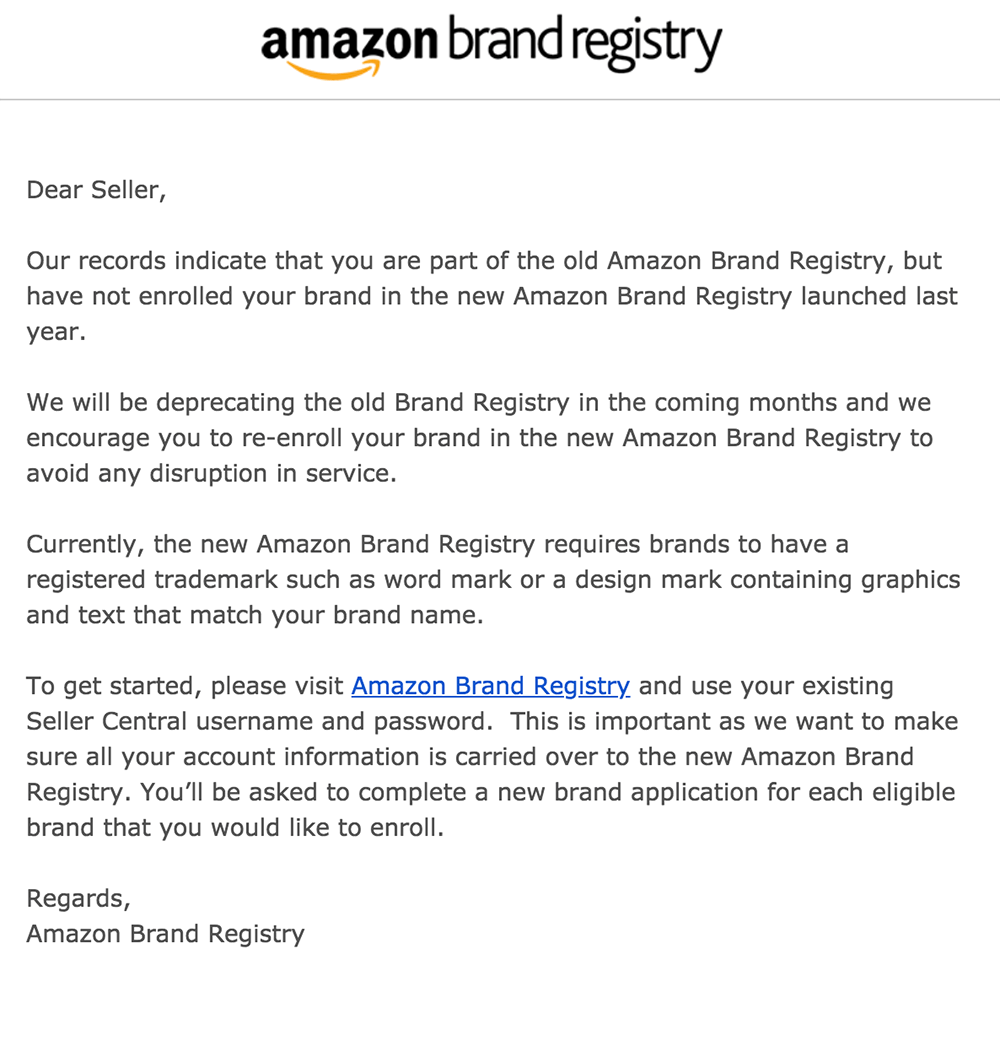
It was good while it lasted, folks. But let’s not get into a panic or a frenzy. If you haven’t already started thinking about getting registered trademarks for your products, let’s start thinking about this now. We’re all in this together!
What we will cover!
Trademarks seemed really scary for a lot of existing sellers, because it was new and something they’d never had to consider before. And for new entrepreneurs in the space, it can also be quite daunting. In this article we’re going to run through everything you need to know about trademarks and Brand Registry including:
- The Brand Registry argument and why you should seriously consider entering as a Private Label seller
- How trademarks work for Amazon sellers
- How to research and apply for a trademark for your product(s)
- Entering Brand Registry – the process and how to get approved
- Tips for managing multiple SKUs and barcodes
Do you need to register your brand?
When I last wrote about this topic, a lot of sellers were still in two minds about whether they should enter the Brand Registry or not. In my opinion, things are fast shifting towards Brand Registry becoming a must have for serious Amazon sellers.
As I outlined then, there are some significant benefits to be had from going to the effort of registering a trademark. Let’s get these all out on the table:
- Increasingly, being in the Brand Registry is the only way to have Amazon on your side when it comes to protecting your brand against hijackers, counterfeit products or people using your brand name or logo
- Brand Registry offers several tools for sellers to search for intellectual property rights violations
- It’s the only way for Private Label sellers to get “Enhanced Brand Content” which means you can create dynamic, visual product listings that convert
- In August 2017, Amazon rolled out a BETA to allow those with access to Enhanced Brand Content to upload a video on their main product image carousel
- Amazon will likely keep improving the Brand Registry service and adding new features for sellers, the sooner you get in there, the sooner you can gain access to new features when they are rolled out
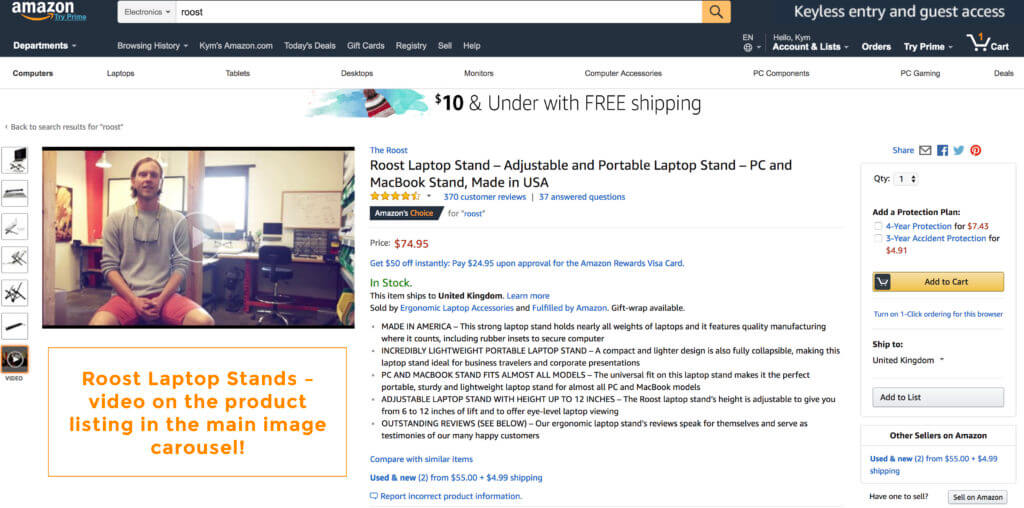
Check out the Roost laptop stand listing – they have a video right there in the images
It’s definitely not a requirement, and I would still fully recommend to launch your products without it. But what you should be doing is planning ahead for getting a trademark, because for your most important products, it’s going to be a really useful tool to have on your side.
Trademarks for Amazon Sellers
Probably the biggest new thing that Amazon sellers have had to contend with over the past 6 months is the concept of having to get a trademark. Many sellers have no experience in this area (myself included), so it’s new territory.
Although getting a trademark comes with associated costs and takes several months to process(!), it’s not something that us sellers should be afraid of.
We applied for some trademarks for some of the Million Dollar Case Study products, Jungle Stix and Jungle Snugs, back in 2017. Those trademarks took over 4 months to be processed, but they are now fully registered trademarks in the US, allowing us to enter those products into the Brand Registry. Result!
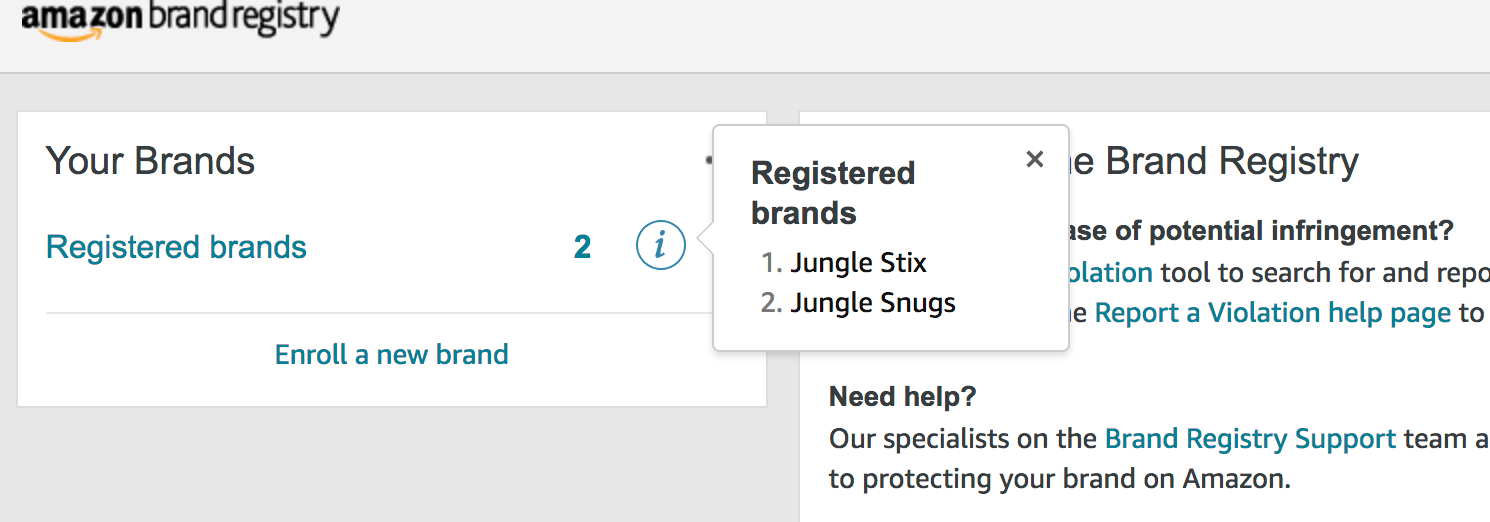
So with this experience in mind, let me share with you some of my top tips for approaching trademarks as an Amazon seller.
Disclaimer: I am in no way providing any legal advise. Instead, I’m sharing what we have found from going through this process with our own products. We would always recommend hiring a professional lawyer to help with this process.
How to research and apply for a trademark for your product(s)
A trademark is a word, phrase, symbol, and/or design that identifies and distinguishes the source of the goods of one party from those of others. – USPTO

What you need to apply for a trademark.
In order to apply for a trademark you will need:
- A legal business, or you can register as an individual with an EIN code if you are just starting out and haven’t registered an LLC or other business entity yet
- A logo or mark that you want to use
- A full legal name and address of the owner (seller)
- A copy of the product as an example. This shows how you are using your mark in commerce – this could be a picture of your product
- The date you first started using your logo or mark or shared it anywhere
- Which International Class you plan to use (or multiple classes – more on this later!)
How to come up with a brand name.
You are going to need to come up with some ideas for brand names that you can use for your product(s). If the thought of picking out a new brand name from thin air fills you with dread, here’s a few useful tools and tips:
- Use a brand name generator. Like Namestation, Shopify’s brand name generator. or even SEO tools like LSI graph that help you come up with semantic word ideas
- Pick a name that is creative and memorable, yet generic. Descriptive names are more difficult to trademark usually.
- Write down all of your ideas. Even the funny or stupid ones. It really helps to take stock of what you have come up with – and then create a shortlist
- Try brainstorming with a friend or family member. Sometimes other people’s ideas can help.
Try not to stress about this too much. At this stage you just need a functional brand name that is available and that you can trademark so that you can start that process and get into the brand registry later on.
Doing the research
Before you apply for anything, the one thing that you really need to make time for is research. One of the main things to research before settling on a brand name for your product is to check it’s not already a registered trademark – otherwise you’re not going to get very far with an application and at worst you could spend time and money, only to get your trademark application refused.
It is actually quite easy to search the trademark database. Here’s a guide on how to search the USPTO database for US trademarks. If you are searching in Europe you can use the EUIPO website to search. An additional old fashion Google search may also help to uncover if any companies or brands are using the name you wish to use.
Tip: Always research to find out if your brand name already has a registered trademark against it
One of the most useful search tools is TMview, which will show a variety of results for trademarks that have been registered all over the world, including which country, which Nice class, and even if there is an associated graphic representation:
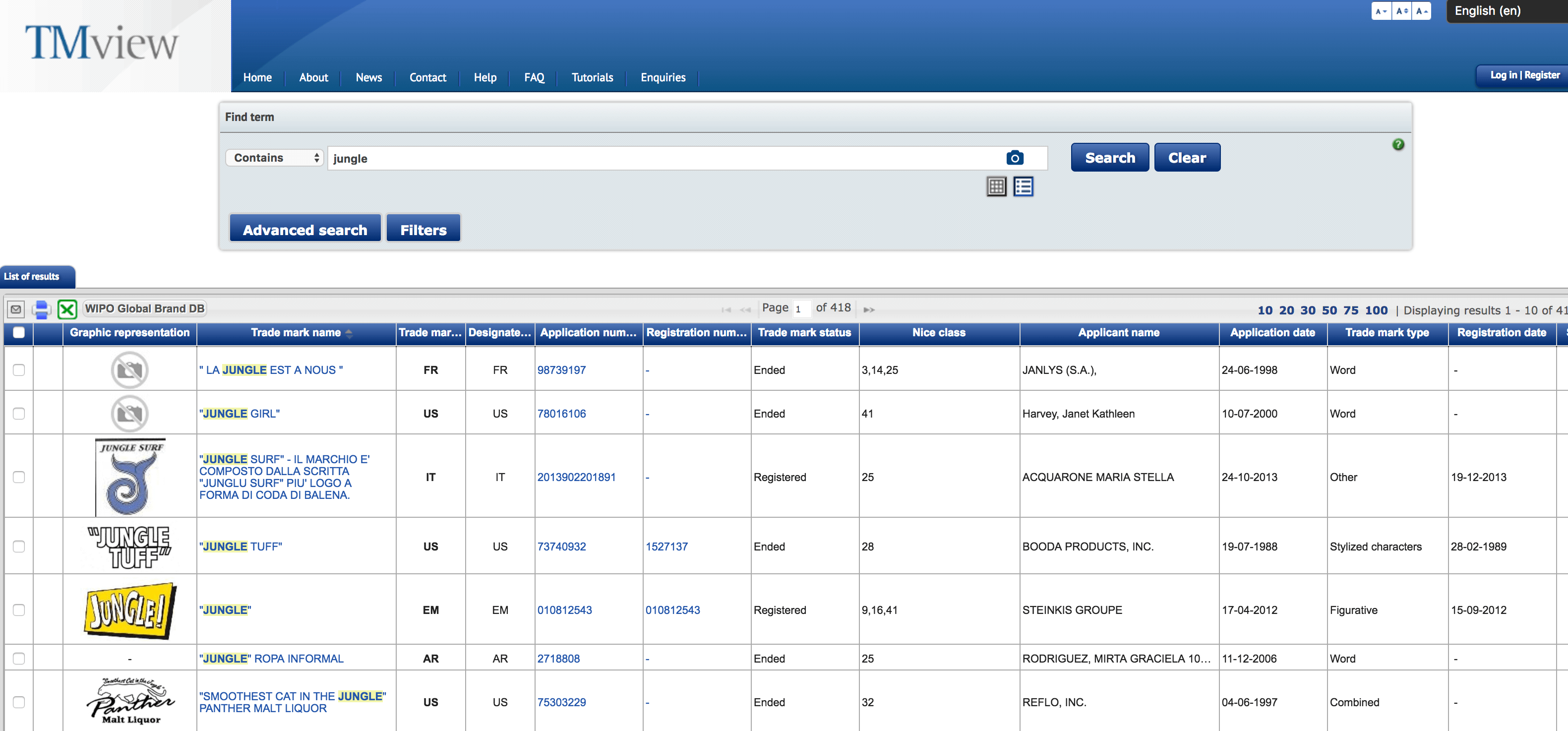
You can also hire a professional to help you carry out comprehensive trademark research.
Companies such as Trademarkengine can help you do this, as well as help you with the application process itself. This may help you save time, as well as offer peace of mind.
Trademark Classifications
You want to find out if your brand name is already registered at all, and secondary to that, if it is, what International Classifications does it fall under?
International trademark classes are also known as “Nice Classifications”. When you apply for any trademark, you will apply in one or several of these classifications.
There’s a comprehensive list of all of the classes on the WIPO website, which can easily be searched by class, alphabetical by name and includes a detailed explanation of what each of the classes actually mean under the ‘Class Headings’ tab.

Applying for a Trademark
Similar to researching if your brand name is available, you can either do this yourself directly by using the USPTO website or the EUIPO website to make an application. I have never tried this myself, but I have heard from sellers in our Facebook group that it’s very time consuming.
For that reason alone, when we applied for the Jungle Stix and Jungle Snugs, we used Trademarkengine.com. It took a few months to process and get the registered trademarks as a result but this is completely normal for any application, no matter how you apply.
One thing that may slow down progress considerably, is if your application is more complicated. For example, if there is a risk that the trademark you are applying for is similar to others, or used for similar products and services. For plain sailing, always try to apply for a trademark for a brand name that you have verified is available to the best of your knowledge.
If you are ever unsure, for example, if you think someone is using your brand name but in a totally different classification, then the best option is to hire a lawyer to provide legal advice and to help you through the process. Ultimately, the best case scenario for any application is that you have not been able to identify any trademarks using your brand name,
Tip: Hiring a lawyer who specializes in intellectual property law can be hugely beneficial to ensure your trademark application runs smoothly!
When do I need a trademark?
Well, there is no requirement to enter the brand registry at all. But for serious sellers it’s a consideration you should really be thinking about as soon as possible.
It’s totally understandable for sellers to avoid the expense and effort involved with applying for a trademark right away, if they first want to verify that their product is going to be a big seller.
Of course, we always advocate spending a lot of time on your product research to minimize the risk of launching a product that does not go on to become one of your big earners. But even if you have done this, you’ve read the resources, you’ve used the tools, and really verified that your product idea is going to fly – you still may want to give it a good run before you invest in a trademark.
I hear you!
But starting your research before you launch is still the best option.
In fact, I’d strongly recommend that you spend some time on this before finalizing your product packaging and branding. To apply for your trademark you are going to need to have the following:
- A brand name, word mark or logo that has not already been taken by another business and registered as a trademark
And to enter the Amazon brand registry you are also going to need:
- The brand name, word mark or logo clearly shown on your product and on the packaging
It would be a royal pain to have to rebrand your product down the line, redesign your packaging and update your Amazon listing. A little preliminary research on what brand name you decide to use goes a long way in ensuring you can get that trademark later, with as little hassle as possible.
Again–it’s not a necessary requirement, but if you are serious about your product and Amazon business, then it’s going to be worth your while.
How to register a brand on Amazon
Once you have been through the whole process and got your trademark, after a short celebration, it’s time to apply to the Amazon Brand Registry. Here’s a quick look at the steps:
- Start the application on Seller Central’s brand registry website.
- Identify your trademark type.
- Upload product images.
- Enter your UPC/barcode information.
- Submit the application and wait.
Note that to do this you need to log in to the Brand Registry website, rather then into your usual Seller Central account. You can use your usual account details and password to sign in.
I recently went through this process with Jungle Stix and Jungle Snugs and I found out a few things along the way. Here’s how the application process goes step by step.
Step 1
Start a new application and answer the following questions:
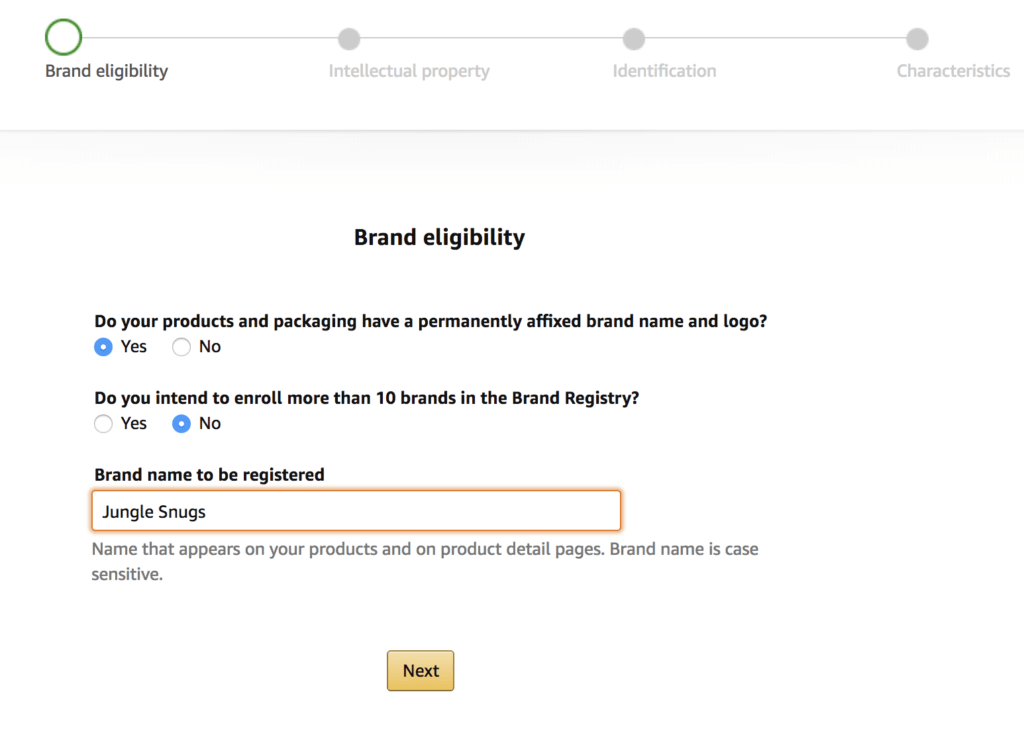
Make sure that the brand name you enter here is the same as the one on your registered trademark certificate.
Step 2
Next up, you need to identify what type of trademark you have (usually a Word mark) and then select your registering office and enter your registration number which will be found on your trademark certificate from the IPO office:

Step 3
Next you will need to upload product images. You can use your existing product photography, packaging photography and an image of your logo.
Important: This is where my initial application got refused. I supplied photos of the packaging that displayed the Word mark (brand name), but I did not include an image of the Word mark and/or logo on the product itself. In this case, I had to resubmit my application with a photo of the Jungle Snugs logo on the fabric tag of the product. For Jungle Stix, we have a photo of the name etched into a bamboo skewer.
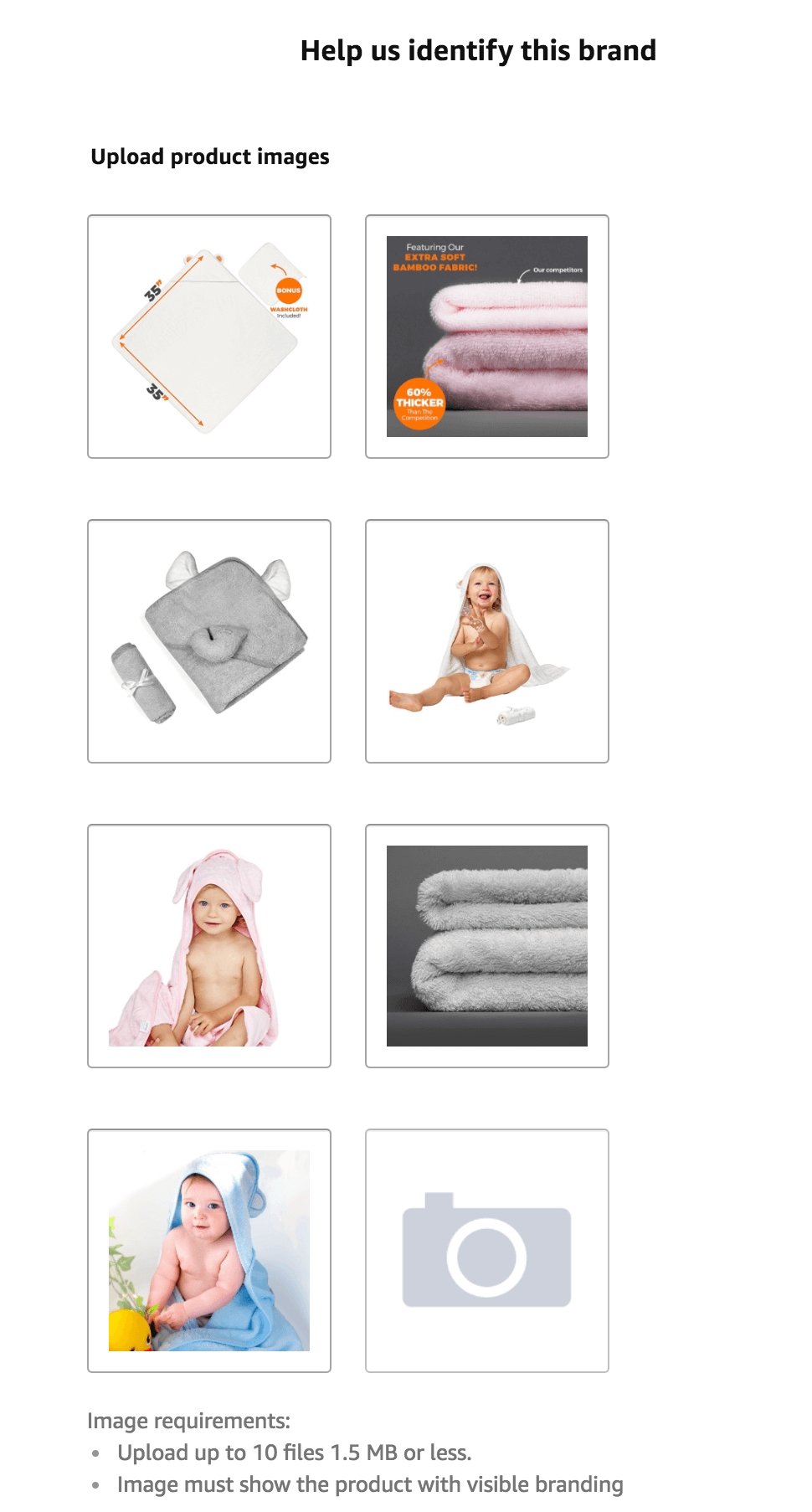
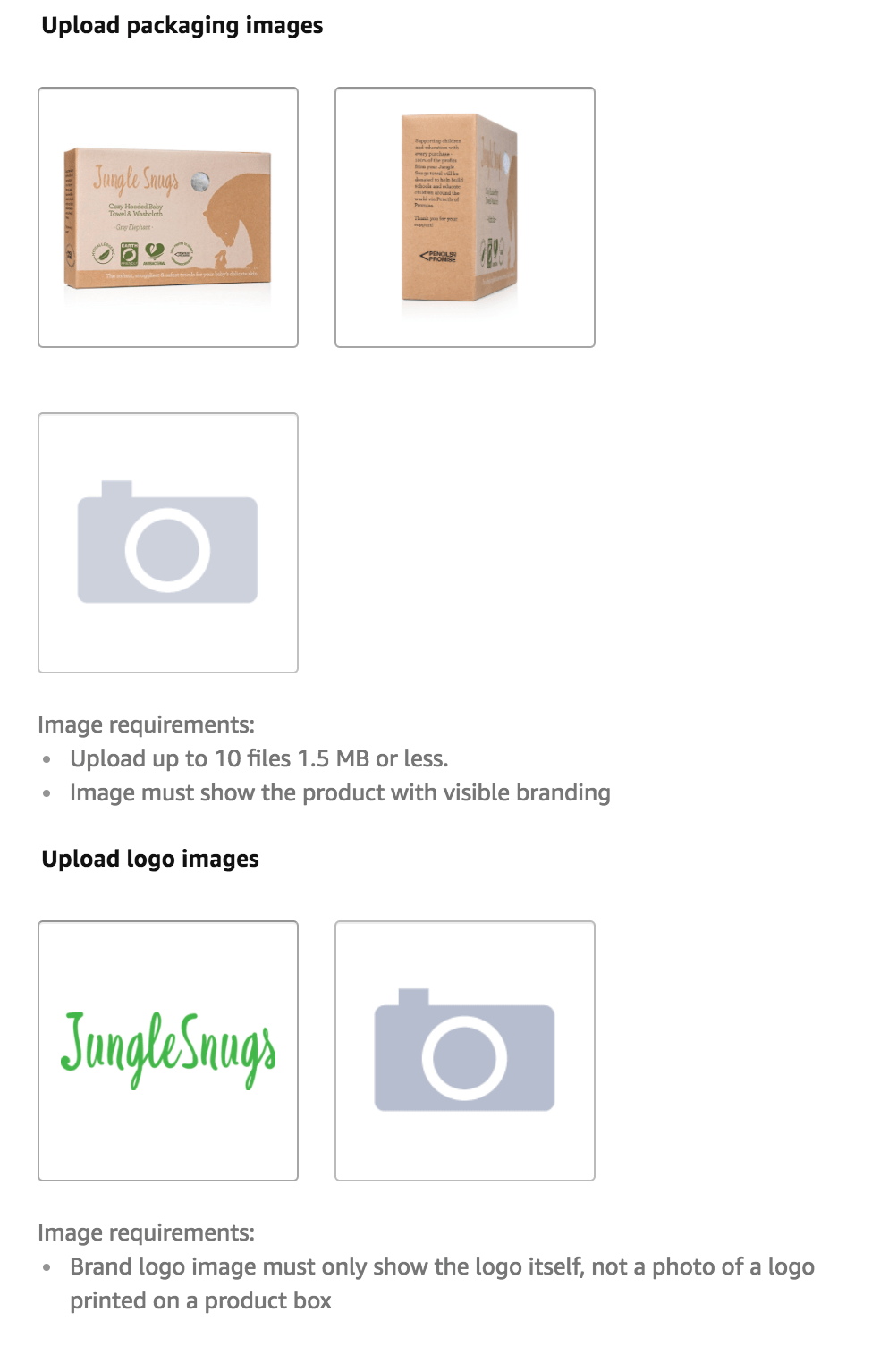
Tip: Always submit images of your trademark brand name on the product itself as well as the packaging to get your application approved.
Step 4
This is where it gets interesting. If you want to create your own “Manufacturer Part Number” for your product and do away with your initial barcode (UPC or EAN) then you need to state that you do not have one, and then select your product category an the type of unique identifier that you want to choose.

A good reason to do this might be if you used a third party barcode to launch your product. Right now it looks like Amazon are clamping down on the use of third party barcodes in favor of verified GS1 barcodes. We’re not sure if existing products will be forced to change their unique identifiers in the future, but one benefit of being in the brand registry is that you can create a listing without a GTIN or a GS1 barcode.
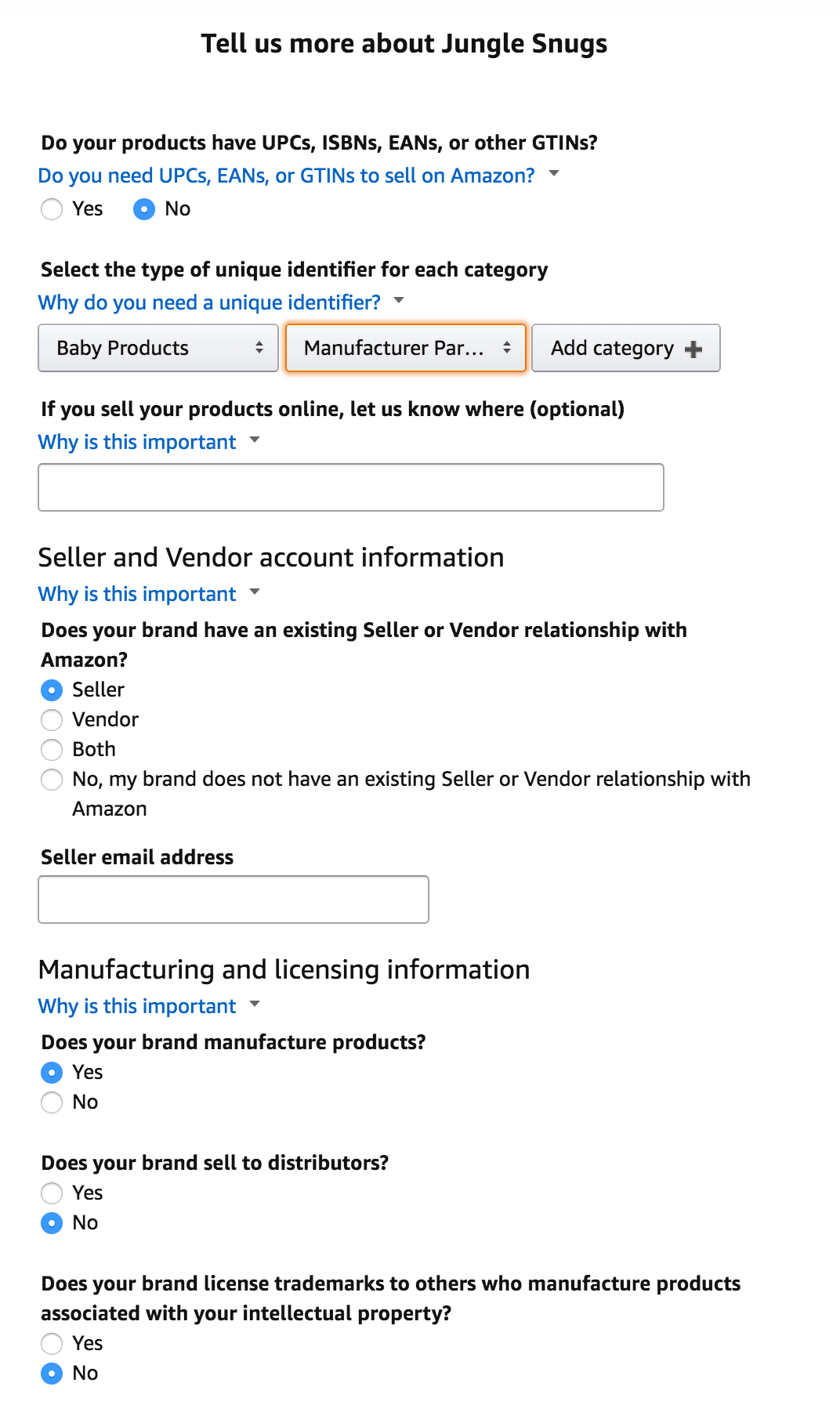
After you have settled whether you want to ditch your original barcode, fill out the rest of this form. Optional fields can be left blank. Remember that as a private label seller, your brand effectively manufactures products and imports them to the country of sale.
Optional fields
There is also an optional area to enter a website for your brand/product and social media links.
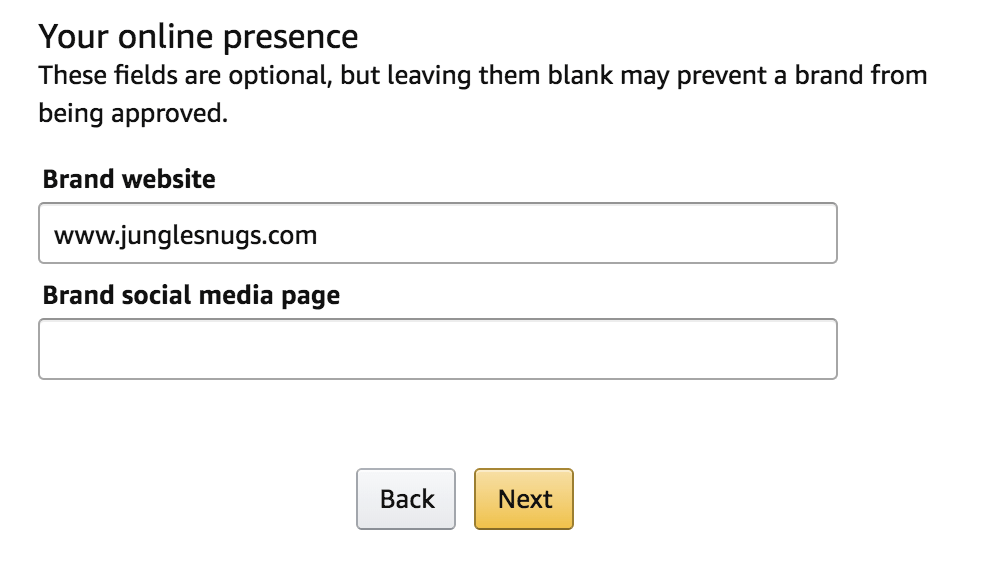
According to the description, leaving these blank may prevent your brand from being approved…
This might indicate that Amazon are planning to require some of these things in future. Or perhaps they are just trying to scare us? Who knows! For the applications I entered the Jungle Snugs and Jungle Stix websites which are non-transactional, simple product websites. It did the trick for me. Drop your comments in this post if you have any experience with these optional fields!
Step 5
Once the application is complete you just need to hit submit and wait. In my experience it took a few days to process. You can keep checking back by logging into the brand registry website to see if your brand(s) have been approved, but Amazon will also notify you by email to let you know if there were any issues with your application, or if it has been approved!

Tips for managing multiple SKUs and barcodes
One question that I see a lot is how do I manage trademarks and brand registry if I have multiple SKUs?
It’s a good question. With each trademark coming with an associated cost and a pretty lengthy application and processing time, most sellers want to optimize as much as possible and avoid going through this same process several times.
We have been advising sellers to go for a generic trademark for some time now, leaving the door open to use the same trademark for more than one SKU.
So rather than the Jungle Stix trademark that we applied for, we could have gone for something more generic like “Jungle Creations“, and then have all the products in our catalogue use this brand name.
I took to our Facebook Group to ask if any sellers have managed to do this successfully. As it turns out, many have done this, but there is one small caveat. You must still register your trademark in all relevant classifications. So if you sell products from entirely different niches that fall under different Nice classes, then you need to register your trademark for both of those classes.
The easiest and most economical way to do this is to register for several classes at once. Depending on where you are applying, you can often add classes to your application to minimize the amount of admin work.
What about multiple marketplaces?
If you already sell your product in multiple marketplaces or plan to do so in the future, this is a worthwhile consideration too.
At the time of writing, the Amazon brand registry page for the US mentions that your trademark must be registered in the United States, Canada, Mexico, India, Australia, Japan, France, Germany, Italy, Spain, the UK or the European Union.
Conversely, the brand registry page for the UK states that the trademark should be registered in France, Germany, Italy, Spain, the UK or by the European Union Intellectual Property Office.
This means that for sellers looking to sell in the US and then move to Europe, it may be more beneficial to register a trademark in Europe, because this will allow you to access the brand registry in the US and in Europe.
Something worth considering before you make an application!
In short…
To round this Amazon seller trademark and brand registry update, the key pointers are that brand registry is not going away, and is becoming more important for private label sellers. The only way to enter now is to have a registered trademark, even if you were in the brand registry before this rule came into place.
Though this makes the process more complicated, it is simply a part of owning a legitimate business with high growth opportunity. If you want to protect your private label products and your brand, whilst getting access to the best marketing tools on the Seller Central platform – then you are going to want to do your homework and start the trademark process.
Let us know in the comments below your thoughts, questions or experiences with getting your products trademarked and into the brand registry!
